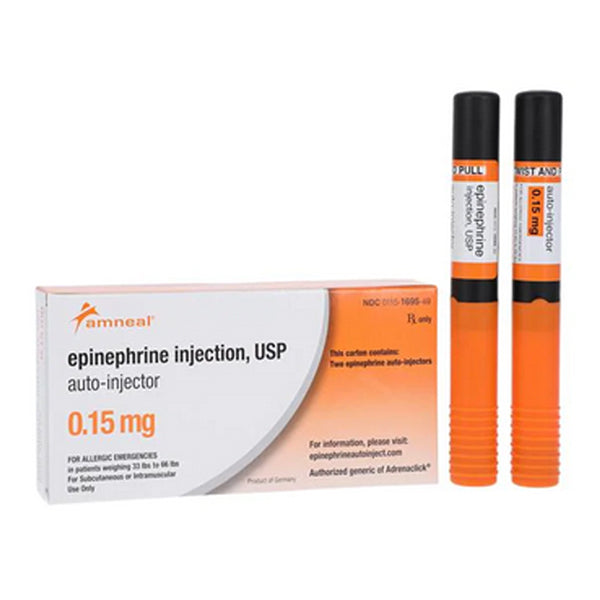Epinephrine Jr Auto-Injector 0.15 mg Injection Syringe For Kids in School & Daycare (2-Pack) (Rx)
How to Order:
You will receive instructions on how to create an account along with Rx Ordering Details.
(Note: Acceptable licenses must have Prescriptive Authority in the license issuing state.)
An Epinephrine Jr Auto-Injector 0.15 mg is a medical device used to deliver a single, fixed dose of 0.15 milligrams (mg) of epinephrine (adrenaline). It is designed specifically for young children (typically weighing 15–30 kg, or about 33–66 pounds) experiencing a severe allergic reaction (anaphylaxis).
Note: This item is Non-Stock. Please allow 2 to 3 business day for Shipping.
Epinephrine Auto-Injector 0.15 mg is used for the emergency treatment of severe allergic reactions (anaphylaxis) in individuals, particularly in children who weigh 15 to 30 kg (33 to 66 lbs). This life-saving device delivers a precise dose of epinephrine to counteract symptoms like difficulty breathing, swelling, or a drop in blood pressure. It works rapidly to stabilize the cardiovascular system and reduce allergic response, buying critical time until medical assistance is available. Immediate administration is crucial to prevent life-threatening outcomes.
Anneal Pharmaceuticals Epinephrine 0.15 mg Injection Auto-Injector Pen 0.15 mL. NDC: 00115-1695-49 Adrenergic Agonist.
What is it for?
- Emergencies: Used for treating sudden, severe allergic reactions (anaphylaxis) caused by food, insect stings, medications, or other allergens.
-
Children: The 0.15 mg ("Jr" or "Junior") dose is for children who weigh between 15 kg (33 lbs) and 30 kg (66 lbs).
- For children/adults above 30 kg, the 0.3 mg auto-injector is used.
How does it work?
-
Epinephrine acts quickly to:
- Open airways (relieves breathing difficulty, wheezing)
- Constrict blood vessels (raises dangerously low blood pressure)
- Reduce swelling and hives
Dosage Strength: 0.15 mg of Epinephrine per 0.15 mL injection
How is it used?
- Remove the safety cap
- Firmly press** the injector against the outer thigh (can inject through clothing)
- Hold in place for several seconds (check the specific product instructions, usually 3–10 seconds)
- Call emergency services right away after using
Brand Names
- EpiPen® Jr
- Auvi-Q® 0.15 mg
- Adrenaclick® 0.15 mg, and generic equivalents
Important:
- Always have the device easily accessible if your child is at risk for anaphylaxis.
- Train caregivers, teachers, and others on how to use it.
- Always seek emergency medical help after use, as symptoms may return and further treatment may be necessary.
Packaging: Two auto-injectors per pack for primary and backup use
Design: Compact, portable, and easy-to-use for rapid administration
Activation: Automatic needle injection with safety guard to minimize needle exposure
Manufacturer: Anneal Pharmaceuticals, a trusted leader in acute care solutions
Mechanism of Action
Epinephrine, a non-selective adrenergic agonist, works by stimulating α- and β-adrenergic receptors. This dual-action mechanism results in vasoconstriction and bronchodilation, effectively counteracting hypotension, bronchospasm, and upper airway edema associated with anaphylaxis. Moreover, epinephrine diminishes vasodilation and vascular permeability, preventing further progression of allergic symptoms and stabilizing the patient’s condition swiftly.
Directions for Use
1. Indication: For emergency intramuscular use in patients experiencing anaphylaxis.
2. Instructions: Grip the auto-injector in your dominant hand.
- Pull off the safety cap and inject into the outer thigh, holding in place for several seconds. The injection can be administered through clothing if necessary.
- Massage the injection area for 10 seconds to promote epinephrine distribution.
3. Repeat Use: Seek emergency medical help immediately, even if symptoms improve. Administer the second auto-injector if symptoms persist after five to fifteen minutes.
Ensure that patients and caregivers are trained in the proper use of the auto-injector.
Warnings
-
Allergy and Medication Conditions: Inform your healthcare provider of any allergies, medications, or cardiovascular conditions.
-
Misuse Risk: Administer only when anaphylaxis is suspected; improper use could lead to serious side effects.
- Storage: Store at room temperature, away from light and out of reach of children. Ensure product is not expired.
Side Effects
While epinephrine administration is crucial for emergency anaphylaxis treatment, potential side effects may occur, including:
-
Common: Anxiety, restlessness, tremors, and palpitations
-
Cardiovascular: Rapid heart rate, arrhythmias, or hypertension
-
Neurological: Dizziness or headache
- Site Reactions: Redness, swelling, or pain at the injection site
Serious adverse events are rare but possible, especially in patients with underlying heart conditions.
Disclaimer
This information provides an educational overview for healthcare providers and caregivers; detailed guidance from a medical professional is essential for its safe, effective use. Make sure to review the full prescribing information and safety warnings that accompany the Epinephrine Auto-Injector 0.15 mg before patient use.





